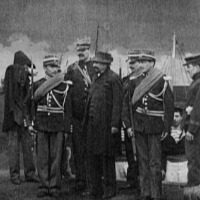BROOKE GLADSTONE:
Today repressive governments routinely censor films they think will incite violence or overly enlighten their citizens.
Susan Daitch's new novel, Paper Conspiracies, is set in part during what may be the earliest example of a government censoring a movie. The government was France and the movie, George Méliès' 1899 The Dreyfus Affair.
[MUSIC UP AND UNDER]
It was banned for 50 years, and not seen again in France until 1974.
[MUSIC]
The 13-minute silent film was the first docudrama, reenacting the tribulations of Army Captain Alfred Dreyfus, falsely convicted of treason and railroaded by the military to protect the real culprit, Major Ferdinand Esterhazy. Ultimately, doctored and suppressed evidence, anti-Semitism and xenophobia landed Dreyfus in Devil's Island, where he spent years in solitary confinement under wretched conditions.
In the waning years of 19th century France, where you stood on Alfred Dreyfus said everything about your view of the world. Méliès' film caused a riot. This was an era flooded with new media, photography, fast printing presses, movies - which were easy to manipulate. So, says Susan Daitch, people chose to believe whatever they liked.
SUSAN DAITCH:
There was also a tremendous generational jump in literacy, and it worked both to support the Dreyfus case and also to condemn him. Both sides used and altered the media.
BROOKE GLADSTONE:
The movie was produced in 1899, about historical events that had transpired between 1893 and 1899.
SUSAN DAITCH:
Mm-hmm [AFFIRMATIVE].
BROOKE GLADSTONE:
Is that the first time that's happened?
SUSAN DAITCH:
Yes. The Dreyfus affair was the first recreation based on photographs and illustrations in weekly newspapers in France at the time. It was a enormous departure for George Méliès, who had previously only made magical fantastic films.
BROOKE GLADSTONE:
You wrote in your novel, "Méliès was an adored man. He offered escape hatches, transformations, jokes. 'No one wants to see what they can see every day,' he said. 'They want to see what they can't see.'"
Then he began to think about filming what everybody looked at but didn't see. And so, what was it that people didn't see about the Dreyfus affair?
SUSAN DAITCH:
Dreyfus' innocence. During the second trial, which occurred in 1899, after Esterhazy, the actual spy, confessed, Dreyfus was convicted a second time. That was when Méliès made the film, to show that Dreyfus was, in fact, innocent, that this was all a constructed case against him.
BROOKE GLADSTONE:
Now, we don't see in the film invented evidence. What we simply see is a man who is driven from pillar to post, from the penal colony -
SUSAN DAITCH:
Yes -
BROOKE GLADSTONE:
- back to trial, clapped in irons?
SUSAN DAITCH:
Dreyfus' brother Matthew published a letter in the press that Dreyfus had escaped from Devil's Island, because he thought Dreyfus was being forgotten. And, in fact, he didn't escape. As a result of that, he was put in irons.
Both sides used and altered the media. They would publish constructed photographs where, for example, one of Dreyfus' lawyers and maybe the editor of a far-right press - you have a photograph of them meeting when, in fact, they had never met.
BROOKE GLADSTONE:
So the film was banned for 50 years.
SUSAN DAITCH:
It wasn't until 1974 when a film that was going to be on television wanted to include some of the footage from the Méliès film, that President Giscard d'Estaing lifted the ban.
BROOKE GLADSTONE:
That was the end of the ban on making films about Dreyfus. Why did it take so long?
SUSAN DAITCH:
I think it's shone a very uncomfortable light on an event that involved a lot of serious mistakes. It wasn't the only film about the Dreyfus trial to be banned in France. The Academy Award-winning 1938 film, The Life of Emile Zola, was also banned in France.
[CLIP/DRUM ROLL]:
JUDGE:
In the name of the people of France, Alfred Dreyfus is condemned to deportation for life. Court martial also orders that prior to the sentence being carried out, that Captain Dreyfus shall be paraded before the garrison of Paris and there publicly degraded and dismissed from the service.
[SOUNDTRACK/UP AND UNDER]
BROOKE GLADSTONE:
What was it about the case that split the country so sharply?
SUSAN DAITCH:
Dreyfus was a very potent symbol for opposing ideologies. He was partly a sym - also a symbol of what was called the syndicate, the - the, the Jewish syndicate that was behind everything that was wrong, the threat of the foreign.
BROOKE GLADSTONE:
It's interesting. This movie was banned from France.
SUSAN DAITCH:
Mm-hmm [AFFIRMATIVE].
BROOKE GLADSTONE:
You can watch it today on YouTube.
SUSAN DAITCH:
Yes, anybody with a computer can watch it anywhere in the world, anytime, yeah.
[OVERTALK]
BROOKE GLADSTONE:
And it's almost meaningless. Did the censors win?
SUSAN DAITCH:
No, I don't think so. You know, as long as we remember the story behind the film. And I think also it's important to think about what it meant for Méliès, that he was not just this magician, which was wonderful - his magical films are wonderful - but that he had this kind of moment of conscience.
BROOKE GLADSTONE:
Susan, thank you very much.
SUSAN DAITCH:
Thank you.
BROOKE GLADSTONE:
Susan Daitch is the author of Paper Conspiracies.
[PATRIOTIC MUSIC/UP AND UNDER]
BOB GARFIELD:
That's it for this week's show. On the Media was produced by Jamie York, Alex Goldman, PJ Vogt, Sarah Abdurrahman and Chris Neary, with more help from Doug Anderson, Liyna Anwar and Hannah Sheehan, and edited – by Brooke. Our technical director is Jennifer Munson. Our engineer this week was Dylan Keefe.
BROOKE GLADSTONE:
Katya Rogers is our senior producer. Ellen Horne is WNYC’s senior director of National Programs. Bassist composer Ben Allison wrote our theme. On the Media is produced by WNYC and distributed by NPR. I'm Brooke Gladstone.
BOB GARFIELD:
And I’m Bob Garfield.
[FUNDING CREDITS]
